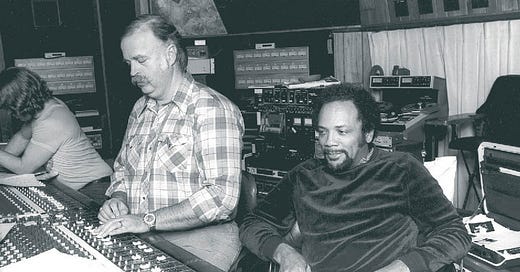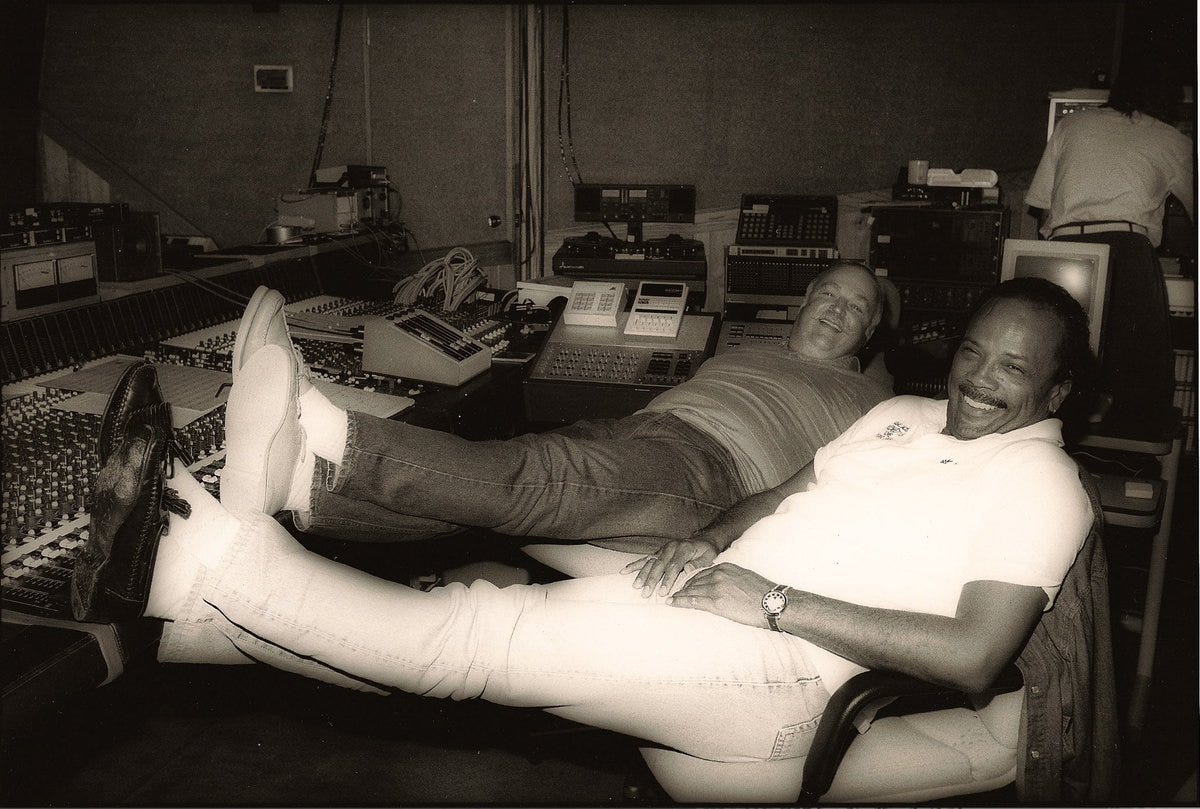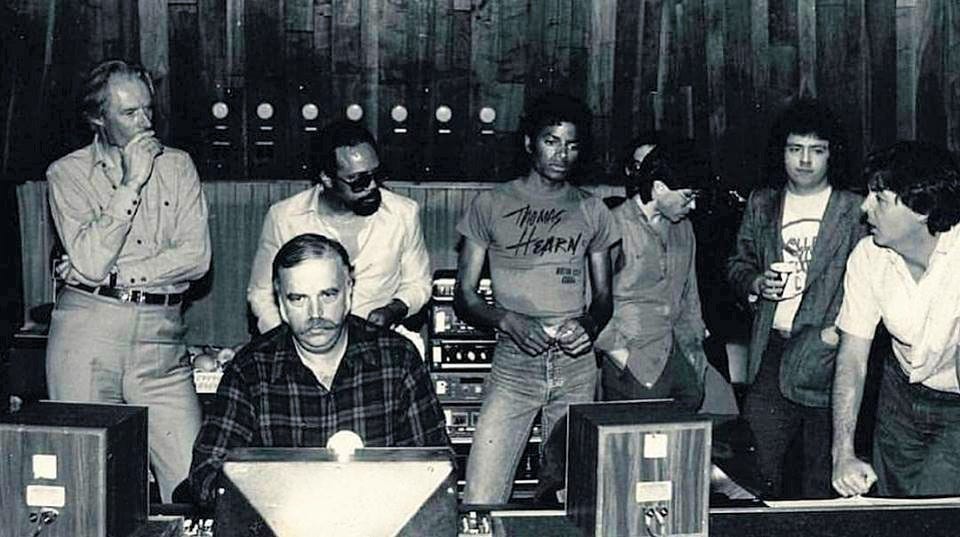Rescued Work: Quincy Jones & Bruce Swedien
DEF|Y|NE Media founder Matthew Allen revisits an erased 2012 article that examined the creative partnership between producer Quincy Jones and engineer Bruce Swedien.
There are two things that I try to accomplish when brainstorming for an article or project:
A story that piques my curiosity.
A perspective that other writers aren’t discussing.
Early in my career, I wrote for Revive Music, the jazz-centric sister page of Okayplayer. Under Revive founder Meghan Stabile’s (RIP) leadership, I had the green light to pitch and write stories and profiles that I would’ve loved to read in other publications.
One such piece examined the working relationship between Quincy Jones and Bruce Swedien. As an avid liner notes reader, I noticed that nearly every album that Jones produced was engineered by Swedien; particularly the trilogy of Michael Jackson albums, Off The Wall, Thriller, and Bad.
Originally titled, Soul and Science: The Partnership of Quincy Jones and Bruce Swedien, my article explored how these two geniuses found each other, made each other better, and changed popular music forever in the process. Since Revive Music’s website is defunct, I present it to you all here at DEF|Y|NE Media:
Presentation is just as important as the product itself. A succulent steak dinner isn’t as appetizing if it’s served on the back of a garbage can lid. In music, this is a principle that is largely taken for granted but overwhelmingly essential to understand.
A great song cannot be a great song without great execution. Aside from the artist, it needs a producer to choose the proper personnel and mold the music as it best serves the material. In addition, it is the engineer’s responsibility to capture the performance in its proper sonic context.
Quincy Jones has earned the distinction of being the greatest producer in music history, mostly due to his collaboration with Michael Jackson. However, it was his paring with someone else during that time that altered and swiftly defined modern pop music: engineer Bruce Swedien.
Between 1976 and 1995, the duo of Jones and Swedien generated platinum-selling records for Jackson, George Benson, Rufus & Chaka Khan, Donna Summer, and many others, thanks to their perfect marriage of spontaneity and calculation. Quincy offered his gift for arranging and orchestrating compositions to fulfill their melodic and rhythmic potential. Bruce contributed his extraordinary way of mixing, using special microphones and other unorthodox methods to maximize the sonic potential of a recording.
The partnership between Quincy Jones and Bruce Swedien was conceived in 1954. They met at Universal Studios in Chicago, both working on a session for Queen of the Blues, Dinah Washington. That session spawned five records, including the top ten Grammy-winning hit, “What a Diff’rence a Day Made.”
Their presence at the session speaks to a recurring resource that each would use, in a radical fashion, to record their commercial smashes later: Jazz. Jones’ pedigree in jazz is well documented. He learned trumpet from Clark Terry, charting from Ray Charles, and played with Lionel Hampton, Dizzy Gillespie, and Billie Holiday. Bruce’s background as an engineer was also rich in the medium, having worked with Duke Ellington, Art Blakey and the Jazz Messengers, and others. From that point, Jones and Swedien clicked instantly. They’d work together periodically for the next 20 years with artists like Washington and Count Basie.
In 1977, Jones invited Swedien to work with him on a movie musical he was scoring and supervising. Swedien jumped at the chance and from that moment, they were inseparable. That movie was The Wiz and was the birth of a steady offspring of projects that would help shape the course of American music.
It was during the pre-recording phase of The Wiz that Swedien witnessed the full gauge of Jones’ uncanny and unparalleled prowess as a producer. Jones amassed a prestigious lineup of singers and jazz musicians to take Charlie Smalls’ score – Jones composed five new songs as well – to a zenith that would be unrivaled by other musicals: Ron Carter, Ralph McDonald, Hubert Laws, Harvey Mason, Bob James, Roberta Flack, Luther Vandross, Cissy Houston, and so on.
Jones explained his methodology in his documentary, Quincy Jones: The Many Lives of Q: “I listen to the orchestra like an x-ray machine because I’ve been around it all my life. That’s what I do. If it’s too thick, too thin, too slow or too fast, wrong key or whatever it is, all I have to do is just listen, and I hear it.”
The Wiz would prove to be the template for the two going forward.
On their next project, Jones’ 1978 solo release Sounds…and Stuff Like That (featuring Vandross, Chaka Khan, and Herbie Hancock), Swedien developed a system of multitrack multiplexing that utilized double stereo microphone recordings, designed exclusively for his work with Jones. This method would later be known as the Acusonic Recording Process, a clever combination of “accurate” and “sonic” coined by Jones and Michael Jackson. Swedien explained further at a 1984 NARAS luncheon: “The ‘accurate’ part of it referred to the accuracy of the true stereophonic sound imagery; the ‘sonic’ part of it referred to the fact that it is sound that we are trying to characterize.”
The Process is the practice of recording into two or more multitrack tape machines so that you can have a nearly unlimited number of tracks. This allowed Swedien to get a “more genuine stereophonic image” instead of a stereo sound simulated by monophonic manipulation, not to mention preventing the master tracks from being played too much during the overdubbing process. In the end, the song’s sound was not only crystal clear but exuded a sphere of sound rather than a wall of sound; giving the listener a virtually live experience.
Within the comfort of the Acusonic Recording Process, Quincy was able to really stretch his imagination in the studio. He assembled an “A-Team” of musicians to use during his and Bruce’s sessions: Rufus drummer JR Robinson, Brothers Johnson bassist Louis Johnson, keyboardist Greg Phillinganes, Toto guitarist Steve Lukather, percussionist Paulindo de Costa and trumpet player Jerry Hey. Jones continued to fuse his jazz arranging skills into the pop context, approaching each album like his big band LPs in the 1950s and 1960s, (i.e. 1969’s Walking in Space) giving the material more urgency and poignancy.
Another key element in Jones and Swedien’s success was constant risk-taking. For his 1981 album The Dude, Jones recruited Ray Charles keyboardist James Ingram…as a vocalist! After hearing him sing on a demo, Ingram was brought to the studio to lend his gruff, masculine timbre to the title track and ballads “Just Once” and “One Hundred Ways,” earning Ingram his first Grammy.
Complimentary, Bruce Swedien also found ways to get that something extra out of a recording. During the Off the Wall sessions, Swedien built a short plywood drum platform to minimize the seepage of reverb into neighboring instrument tracks, thus richen its power (best example is on “Rock with You”). He decided to let Michael Jackson stand on top of the platform in the recording booth while recording lead vocals. This captured all the rhythmic non-vocal nuances of Jackson’s dancing, hand claps, and finger snaps into the track. Jackson recorded with that platform for the rest of his career.
Part of Swedien’s genius was the fact that he didn’t follow the engineer’s “rule book” to the letter and always stayed open-minded to come up with unique to enhance a recording. “I will always sacrifice a technical value for a production value,” Swedien stated in his autobiography, Make Mine Music. “If I were looking for a very ‘breathy,’ sensuous vocal sonic image, for instance, I would place the singer as close as physically possible to the microphone, thereby eliminating almost all early reflections. I would even use no windscreen, if possible.”
(L-R: George Martin, Bruce Swedien, Quincy Jones, Michael Jackson, Jeff Porcaro, Steve Lukather, and Paul McCartney during a recording session of Thriller single, “The Girl is Mine,” at Westlake Audio in Hollywood in 1982.)
At the end of the mixing stage, Jones and Swedien both wanted to make sure that the public would not only get off on the power of the music’s performance and emotions but also appreciate the sound quality. It was crucial that the music had sonic clarity, shine, and impact that enhanced the quality of the already beautiful music.
In the Many Lives of Q documentary, Toto guitarist and A-Team member Steve Lukather talked about the duo’s philosophy during Michael Jackson’s Thriller sessions: “We’d do a track and of course, you come back and they put it on the big speakers and it sounds all big and huge. Then Quincy would say, ‘Put it on the radio,’ because he wanted to see if it had the same vibe.” If the listener got the same impact through small speakers as they did through big ones, then the recording was finished.
By the end of the century, Quincy Jones and Bruce Swedien were a two-headed cultural conglomerate; responsible for countless million sellers and No. 1 singles, including Rufus’ “Do You Love What You Feel,” George Benson’s “Give Me the Night,” Patti Austin’s “Baby Come to Me,” Michael Jackson’s “Billie Jean,” The Brothers Johnson’s “Stomp,” Quincy’s “The Secret Garden,” James Ingram’s “Yah Mo Be There,” Jones and Tamia’s “You Put a Move On My Heart,” and a score of others. To this day, digital recording programs like Pro Tools fight to live up to the duo’s clairvoyant approach to analog recording.
Their success wasn’t just based on talent, intuitiveness, and ingenuity, but also friendship, admiration, and respect for each other and the music. “We had the perfect balance of soul and science – it’s always about that,” Jones stated in his book, Q on Producing. “There’s always a science behind the passion and fire in music – it’s what enables the artist to fully unleash his or her creativity. People think it’s all about nature’s innate talent. No way!”
THANK YOU FOR READING! If you enjoyed this piece, please subscribe to my page and share the piece on social media. Thanks again, and stay tuned for more!






